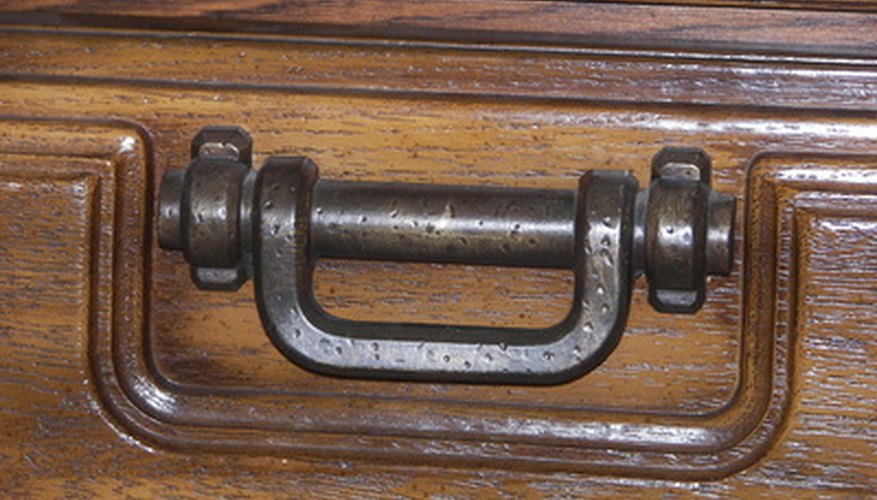Keeping your valuable or private items safe from children and coworkers is critical to just about everyone's peace of mind. Unfortunately, many desks--at home and at work--don't have locking drawers. If the key is long lost, or there simply isn't a lock on the drawer, a little ingenuity worthy of MacGyver will go a long way toward keeping your stuff safe.
Measure the distance from the drawer handle screw to the top of the drawer. Add 1/2 inch to this measurement and cut a piece of 1-inch wide, 14-gauge flat steel to this size, or have a metal shop do it for you. Drill a hole slightly larger than the screw in your drawer handle, approximately ¼ inch from the end of the piece of steel.
- Keeping your valuable or private items safe from children and coworkers is critical to just about everyone's peace of mind.
- Drill a hole slightly larger than the screw in your drawer handle, approximately ¼ inch from the end of the piece of steel.
Remove a screw from one side of the drawer handle using a small adjustable wrench and a screwdriver. If the screw doesn't go all the way through the front of the drawer, drill it out. Insert a machine screw long enough to pass through the front of the door with about ½ inch showing on the inside. Tighten it in place with the nut.
Position the piece of steel so that it catches on the drawer frame when turned upward. Tighten two nuts on either side of the steel. The steel should turn from a horizontal to vertical orientation when the screw head on the drawer handle is turned.
Shut the drawer, turn the screw clockwise, and see if the drawer locks. Keep a screwdriver on your desk to lock and unlock your drawer.
- Position the piece of steel so that it catches on the drawer frame when turned upward.
- Shut the drawer, turn the screw clockwise, and see if the drawer locks.
Pull out the chair and see if you have access to the backs of the drawers. If not, you'll have to lie on your back under the desk, or turn the desk over.
Remove the drawer to be locked and screw the turnbuckle eyelet into the back of it, on the side of the drawer closest to your chair. Replace the drawer.
- Remove the drawer to be locked and screw the turnbuckle eyelet into the back of it, on the side of the drawer closest to your chair.
Screw the hook mechanism from the turnbuckle into the back of the desk directly behind the eyelet. Attach the two parts and try opening the drawer. If there is movement, tighten the turnbuckle.
Drill a small hole into the end of a short length of ¼-inch dowel. Tightly wire this end to the turnbuckle and attach the opposite end to the front of your desk using a small piece of Velcro. Use this to lock and unlock your drawer, instead of crawling under your desk.
Remove the drawer or open the cabinet door under the drawer you wish to lock. If it's a small drawer, remove the drawer under it, as well. You have to be able to see and have access to the area under the drawer to be locked.
Get on your hands and knees and look up at the drawer slides. If the slide consists of a wheel running in a track mounted under the drawer, fold a bit of paper and push it into the track in front of the wheel. Using the smallest, one-handed speed clamp you can find, tighten the paper inside the track channel.
- Remove the drawer or open the cabinet door under the drawer you wish to lock.
- Using the smallest, one-handed speed clamp you can find, tighten the paper inside the track channel.
Try opening the drawer. It shouldn't budge. Replace the drawers.
TIP
The inside panel between the chair and drawers can be easily removed on some desks. There are a number of plastic devices available for toddler-proofing drawers and cabinets, available at most department stores.
